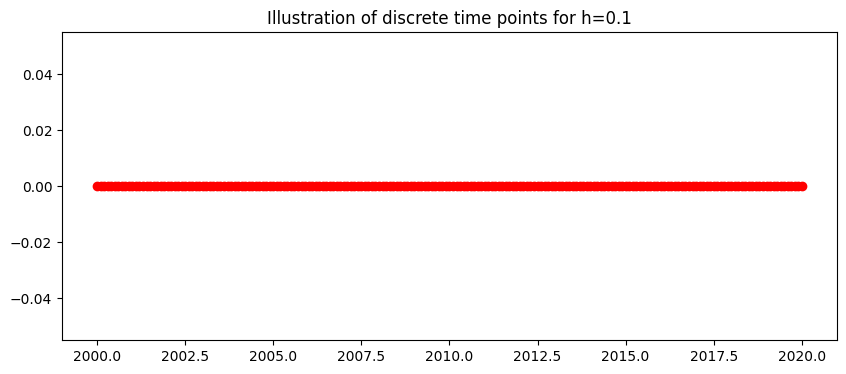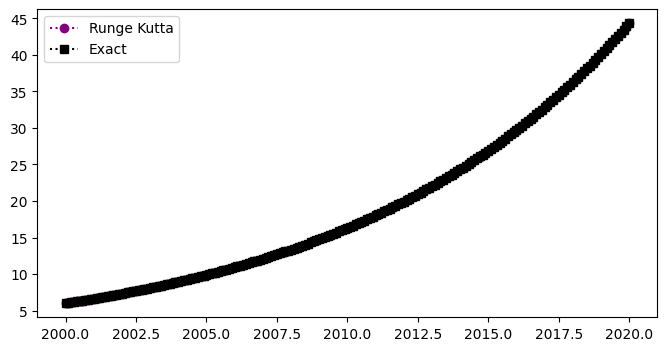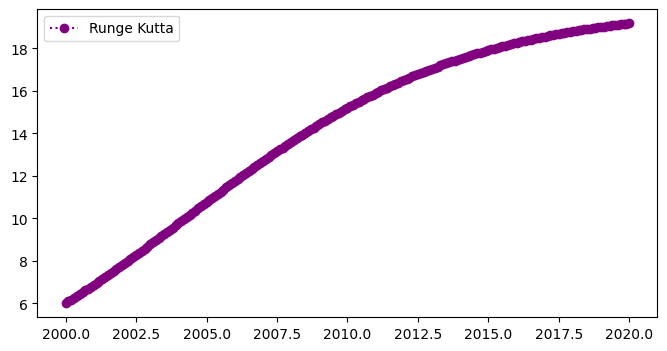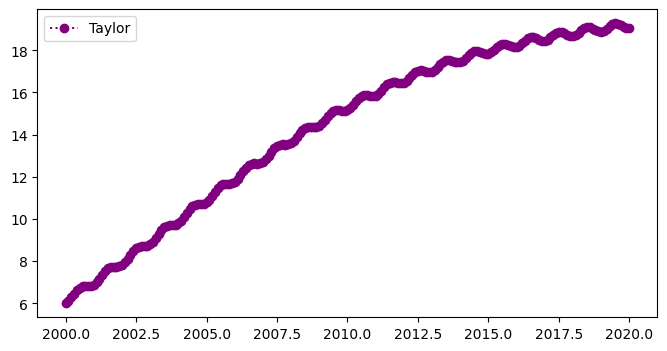Application of 2nd order Runge Kutta to Populations Equations#
This notebook implements the 2nd Order Runge Kutta method for three different population intial value problems.
2nd Order Runge Kutta#
The general 2nd Order Runge Kutta method for to the first order differential equation
numerical approximates \(y\) the at time point \(t_i\) as \(w_i\) with the formula:
for \(i=0,...,N-1\), where
and
and \(h\) is the stepsize.
To illustrate the method we will apply it to three intial value problems:
1. Linear#
Consider the linear population Differential Equation
with the initial condition,
2. Non-Linear Population Equation#
Consider the non-linear population Differential Equation
with the initial condition,
3. Non-Linear Population Equation with an oscillation#
Consider the non-linear population Differential Equation with an oscillation
with the initial condition,
Setting up Libraries#
## Library
import numpy as np
import math
import pandas as pd
%matplotlib inline
import matplotlib.pyplot as plt # side-stepping mpl backend
import matplotlib.gridspec as gridspec # subplots
import warnings
warnings.filterwarnings("ignore")
Discrete Interval#
The continuous time \(a\leq t \leq b \) is discretised into \(N\) points seperated by a constant stepsize
Here, the interval is \(2000\leq t \leq 2020,\)
This gives the 201 discrete points:
This is generalised to
The plot below shows the discrete time steps:
N=200
t_end=2020.0
t_start=2000.0
h=((t_end-t_start)/N)
t=np.arange(t_start,t_end+h/2,h)
fig = plt.figure(figsize=(10,4))
plt.plot(t,0*t,'o:',color='red')
plt.title('Illustration of discrete time points for h=%s'%(h))
plt.show()

1. Linear Population Equation#
Exact Solution#
The linear population equation
with the initial condition,
has a known exact (analytic) solution
Specific 2nd Order Runge Kutta#
To write the specific 2nd Order Runge Kutta method for the linear population equation we need
def linfun(t,w):
ftw=0.1*w
return ftw
this gives
and the difference equation
for \(i=0,...,199\), where \(w_i\) is the numerical approximation of \(y\) at time \(t_i\), with step size \(h\) and the initial condition
w=np.zeros(N+1)
w[0]=6.0
## 2nd Order Runge Kutta
for k in range (0,N):
k1=linfun(t[k],w[k])
k2=linfun(t[k]+h,w[k]+h*k1)
w[k+1]=w[k]+h/2*(k1+k2)
Plotting Results#
y=6*np.exp(0.1*(t-2000))
fig = plt.figure(figsize=(8,4))
plt.plot(t,w,'o:',color='purple',label='Runge Kutta')
plt.plot(t,y,'s:',color='black',label='Exact')
plt.legend(loc='best')
plt.show()

Table#
The table below shows the time, the Runge Kutta numerical approximation, \(w\), the exact solution, \(y\), and the exact error \(|y(t_i)-w_i|\) for the linear population equation:
d = {'time t_i': t[0:10], 'Runge Kutta':w[0:10],'Exact (y)':y[0:10],'Exact Error':np.abs(np.round(y[0:10]-w[0:10],10))}
df = pd.DataFrame(data=d)
df
| time t_i | Runge Kutta | Exact (y) | Exact Error | |
|---|---|---|---|---|
| 0 | 2000.0 | 6.000000 | 6.000000 | 0.000000 |
| 1 | 2000.1 | 6.060300 | 6.060301 | 0.000001 |
| 2 | 2000.2 | 6.121206 | 6.121208 | 0.000002 |
| 3 | 2000.3 | 6.182724 | 6.182727 | 0.000003 |
| 4 | 2000.4 | 6.244861 | 6.244865 | 0.000004 |
| 5 | 2000.5 | 6.307621 | 6.307627 | 0.000005 |
| 6 | 2000.6 | 6.371013 | 6.371019 | 0.000006 |
| 7 | 2000.7 | 6.435042 | 6.435049 | 0.000007 |
| 8 | 2000.8 | 6.499714 | 6.499722 | 0.000009 |
| 9 | 2000.9 | 6.565036 | 6.565046 | 0.000010 |
2. Non-Linear Population Equation#
with the initial condition,
Specific 2nd Order Runge Kutta for the Non-Linear Population Equation#
To write the specific 2nd Order Runge Kutta method we need
this gives
and the difference equation
for \(i=0,...,199\), where \(w_i\) is the numerical approximation of \(y\) at time \(t_i\), with step size \(h\) and the initial condition
def nonlinfun(t,w):
ftw=0.2*w-0.01*w*w
return ftw
w=np.zeros(N+1)
w[0]=6.0
## 2nd Order Runge Kutta
for k in range (0,N):
k1=nonlinfun(t[k],w[k])
k2=nonlinfun(t[k]+h,w[k]+h*k1)
w[k+1]=w[k]+h/2*(k1+k2)
Results#
The plot below shows the Runge Kutta numerical approximation, \(w\) (circles) for the non-linear population equation:
fig = plt.figure(figsize=(8,4))
plt.plot(t,w,'o:',color='purple',label='Runge Kutta')
plt.legend(loc='best')
plt.show()

Table#
The table below shows the time and the Runge Kutta numerical approximation, \(w\), for the non-linear population equation:
d = {'time t_i': t[0:10],
'Runge Kutta':w[0:10]}
df = pd.DataFrame(data=d)
df
| time t_i | Runge Kutta | |
|---|---|---|
| 0 | 2000.0 | 6.000000 |
| 1 | 2000.1 | 6.084332 |
| 2 | 2000.2 | 6.169328 |
| 3 | 2000.3 | 6.254977 |
| 4 | 2000.4 | 6.341270 |
| 5 | 2000.5 | 6.428197 |
| 6 | 2000.6 | 6.515747 |
| 7 | 2000.7 | 6.603909 |
| 8 | 2000.8 | 6.692672 |
| 9 | 2000.9 | 6.782025 |
3. Non-Linear Population Equation with an oscilation#
with the initial condition,
Specific 2nd Order Runge Kutta for the Non-Linear Population Equation with an oscilation#
To write the specific 2nd Order Runge Kutta difference equation for the intial value problem we need
which gives
and the difference equation
for \(i=0,...,199\), where \(w_i\) is the numerical approximation of \(y\) at time \(t_i\), with step size \(h\) and the initial condition
def nonlin_oscfun(t,w):
ftw=0.2*w-0.01*w*w+np.sin(2*np.math.pi*t)
return ftw
w=np.zeros(N+1)
w[0]=6.0
## 2nd Order Runge Kutta
for k in range (0,N):
k1=nonlin_oscfun(t[k],w[k])
k2=nonlin_oscfun(t[k]+h,w[k]+h*k1)
w[k+1]=w[k]+h/2*(k1+k2)
Results#
The plot below shows the 2nd order Runge Kutta numerical approximation, \(w\) (circles) for the non-linear population equation:
fig = plt.figure(figsize=(8,4))
plt.plot(t,w,'o:',color='purple',label='Taylor')
plt.legend(loc='best')
plt.show()

Table#
The table below shows the time and the 2nd order Runge Kutta numerical approximation, \(w\), for the non-linear population equation:
d = {'time t_i': t[0:10],
'Runge Kutta':w[0:10]}
df = pd.DataFrame(data=d)
df
| time t_i | Runge Kutta | |
|---|---|---|
| 0 | 2000.0 | 6.000000 |
| 1 | 2000.1 | 6.113722 |
| 2 | 2000.2 | 6.276109 |
| 3 | 2000.3 | 6.458005 |
| 4 | 2000.4 | 6.623032 |
| 5 | 2000.5 | 6.741504 |
| 6 | 2000.6 | 6.801784 |
| 7 | 2000.7 | 6.814712 |
| 8 | 2000.8 | 6.809444 |
| 9 | 2000.9 | 6.822305 |

